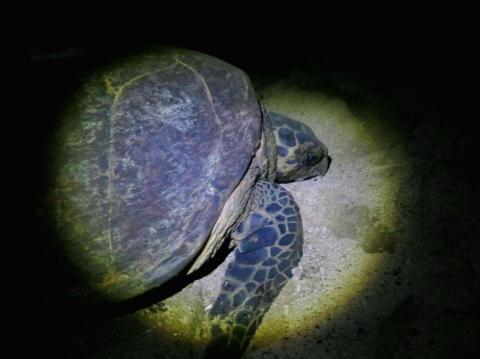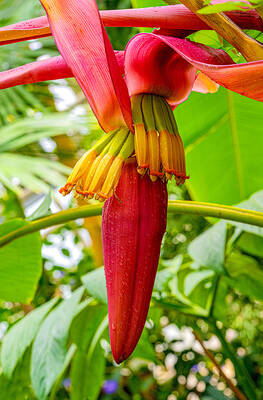In a great discovery in Penghu’s conservation history, the first-ever recorded instance of a hawksbill sea turtle coming ashore to lay eggs occurred recently. A research team led by Professor Cheng I-jiun of the National Taiwan Ocean University recorded the rare scene of a hawksbill turtle crawling onto the beach at Beiliao Village in Husi Township to lay its eggs. It was only after a member of the public reported two years ago that a big turtle and a smaller one had come ashore at Kueibishan in Beiliao that the research team set up camp there and made the discovery.
Penghu is a paradise for sea turtles. Of the world’s seven sea turtle species, five can be found on Penghu. However, the main subject of research has for a long time been green sea turtles, which are the most numerous. The main focus has all along been on the Penghu Wangan Island Green Turtle Refuge, while records of hawksbills coming onshore to lay eggs on the main island of Penghu have been overlooked. This year there have been several reports of sea turtles coming ashore to lay their eggs at Kueibishan, so the Penghu County Government Agriculture and Fisheries Bureau invited Cheng’s research team to go to Beiliao and investigate, otherwise this important discovery in the history of hawksbill conservation could not have been made.
The last time a hawksbill turtle was seen laying eggs in this country was on the Dongsha (Pratas) Islands in 1994. Now, after a gap of 21 years, a hawksbill has finally come ashore again, and this is the first recorded instance of a hawksbill coming ashore to lay eggs on Taiwan or Penghu. Compared to the two and a half hours that green sea turtles need to spend ashore to lay their eggs, the hawksbill only took an hour and a half, during which it dug five separate body pits and finally laid 146 eggs, two of which were damaged because they were squeezed against coral or rocks.

Photo courtesy of the Penghu County Government Agriculture and Fisheries Bureau
照片由澎湖縣政府農漁局提供
The research team recorded the hawksbill turtle as having a straight carapace length of 78 centimeters and a straight carapace width of 16.5 centimeters, while its nest was 49 centimeters deep. Because the nest in which it laid its eggs was very near the sea’s edge, and given that there was a typhoon approaching, the research team has moved it by hand to a higher place on the same beach so that they can continue to observe it. The Agriculture and Fisheries Bureau will send its staff to monitor the nest and keep tabs on what is going on in relation to this first instance of hawksbill turtle eggs hatching in this country in 21 years. The data they collect will be very valuable for hawksbill sea turtle conservation in Penghu.
(Liberty Times, translated by Julian Clegg)
澎湖保育史上重大發現,首度有玳瑁登岸產卵紀錄。海洋大學程一駿教授領軍的研究團隊,在湖西鄉北寮村記錄到玳瑁登岸產卵的珍貴畫面。兩年前就有民眾通報北寮奎壁山有一大一小海龜登岸,才在農漁局要求下,研究團隊進駐發現。
澎湖是海龜天堂,全世界七種海龜,澎湖就有五種,但長期以來研究重點放在族群最多的綠蠵龜上,都以望安綠蠵龜保育區為主,卻漠視澎湖本島海龜登岸產卵紀錄。今年奎壁山多次通報發現海龜登岸產卵,因此澎湖縣政府農漁局邀請的程一駿研究團隊進駐北寮調查,才有海龜保育史上重大發現。
我國上次發現玳瑁產卵,是一九九四年在南海東沙群島上;闊別二十一年,終於再有玳瑁上岸,同時也是台澎首次發現玳瑁登岸產卵紀錄,相較於綠蠵龜登岸產卵需時兩個半小時,玳瑁僅需一個半小時,分別挖了五個體洞,最後才產下一百四十六顆卵,其中兩顆卵因受到珊瑚礁石的擠壓而破損。
研究團隊調查,玳瑁背甲直線長為七十八公分,直線寬為六十.五公分,卵窩深度為四十九公分,由於產卵卵窩位置非常靠近海邊,又逢颱風來襲,研究團隊已進行卵窩人工移位,移至同沙灘較高的位置以利日後觀察,農漁局將派員進行監測,確實掌控我國二十一年來首見的玳瑁龜卵孵化情形,成為澎湖海龜保育珍貴的研究資料。
(自由時報記者劉禹慶)

Have you ever wondered why “Manila envelopes” carry that name? The answer lies in a plant native to the Philippines. Though a fruit-producing plant, abaca is most valued for its leaf stalks, which are __1__ to extract fibers known as “Manila hemp.” These fibers are known for their strength and resistance to saltwater. Because of its __2__ in sea environments, Manila hemp has long been used to make Manila rope, a staple in the sailing and maritime industries for centuries. It withstands harsh ocean conditions without its flexibility being __3__. Manila rope doesn’t break down easily when exposed to

A: In addition to boyband Energy’s concerts, Taiwan’s first major male dance revue has attracted attention. B: Several South Korean male dance revues and Australia’s Thunder from Down Under often tour Taiwan. Now Taiwan’s first all-male revue has finally appeared. A: According to the Liberty Times, Muscle High: A Male Dance Revue from Taiwan, featuring 13 hunks, opened last month and will run until Sept. 14. B: The rise of “hunk fever” in recent years has even caused a trend of working out in Asia. A: Let’s go to the Taipei Music Center’s Sub Livehouse for the show. A:

A: Any fun events happening this weekend? B: Boyband Energy’s concerts and Taiwan’s first major male dance revue have both sparked anticipation recently. A: Energy staged a comeback last year — 15 years after they disbanded — and they’re now more popular than ever. B: Their megahit “Friday Night” even won Song of the Year at the Golden Melody Awards. A: To pay tribute to the Queen of Pop Madonna, they added her choreography of 16 continuous jump squats to their music video, prompting a “16-squat challenge” that went viral across Taiwan. Do you wanna try it out? A:

In a major step to combat carbon emissions, Norway’s pioneering “Northern Lights project” is set to expand its carbon capture and storage (CCS) capabilities. Backed by energy giants and the Norwegian government, this collaborative project is working to increase its annual carbon storage capacity from 1.5 million to over five million tons. Northern Lights focuses on capturing CO2 emissions from industrial sources across Europe and securely storing them underground. Captured CO2 will be liquefied and transported by ship to the storage facility located off the coast of Norway. It will be injected through pipes into geological formations about 2,600m below the